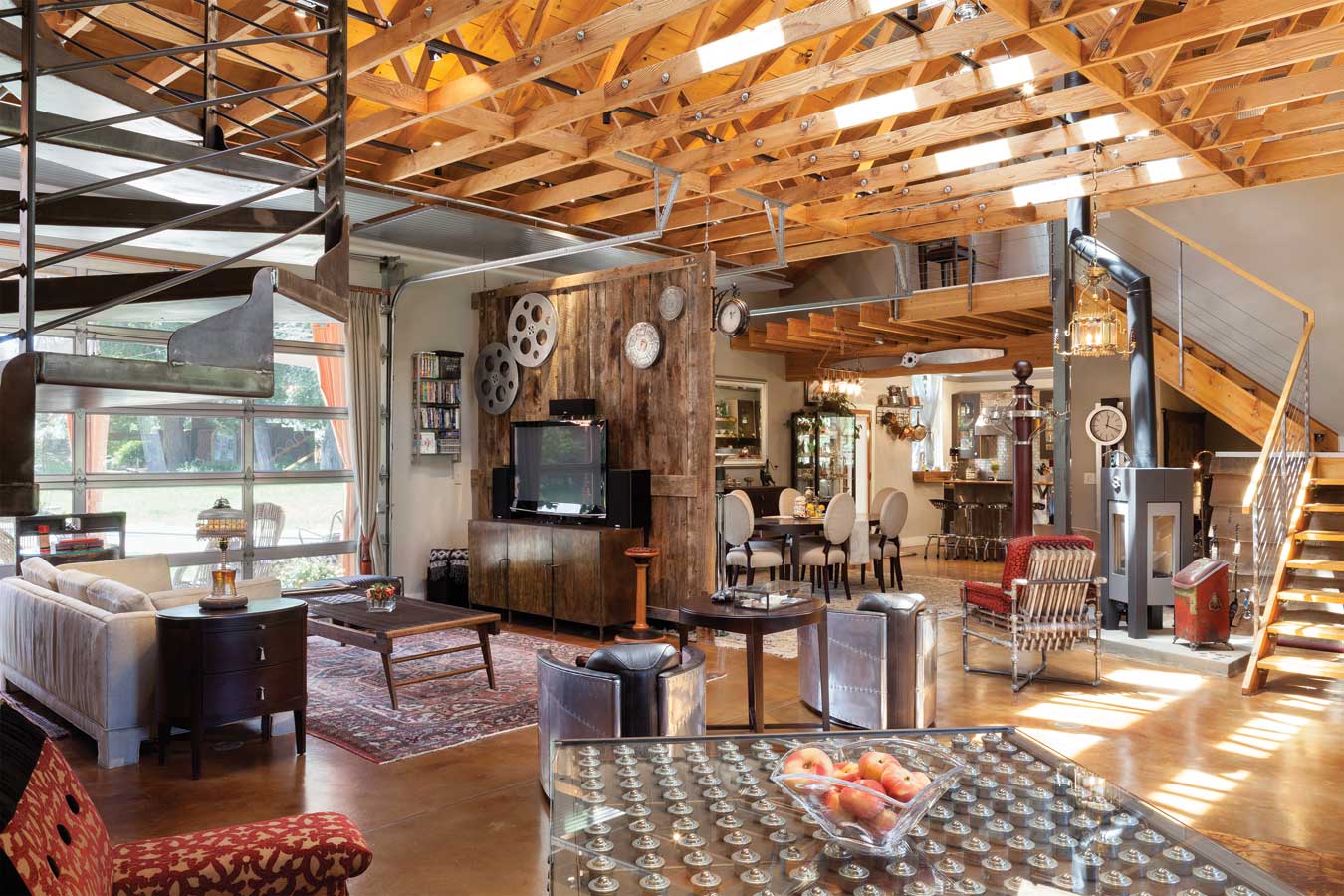Beast to Beauty – Feature Garden
05 Apr 2015
This yard morphed from a pile of ugly mulch to the site of a wedding and a garden tour.
By Lisa Truesdale Photos by Kate Zari Roberts and Richard Gillies When Kirsten Gillies first saw her future husband’s home in northeast Longmont, she was amazed. As one of the neighborhood’s former model homes, it had elegant, upgraded features that made Kirsten think, “Wow!”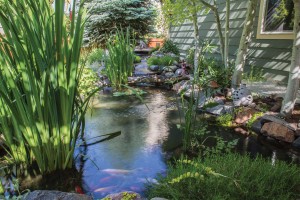 She was also a little wowed by the backyard, but not in a good way. “It was pretty much barren, except for a concrete patio slab, a dilapidated trampoline and a couple of Adirondack chairs.” She told her then-fiancé, Richard, that his “bachelor yard” desperately needed color. “He said, ‘It does have color. Look!’—and he pointed to a pile of ugly dyed mulch.”
The couple got right to work on the yard—“Richard was a willing participant, and he wondered why he hadn’t worked on it sooner,” Kirsten says—and it was gorgeously ready to be the site of their wedding after two years of toiling on it nearly every weekend. In a few more years, it was chosen to be a featured garden on the Longmont Symphony Guild’s Festival of Flowers Garden Tour.
“We worked really hard, but we learned a lot,” Kirsten says, “so it was worth it.”
She was also a little wowed by the backyard, but not in a good way. “It was pretty much barren, except for a concrete patio slab, a dilapidated trampoline and a couple of Adirondack chairs.” She told her then-fiancé, Richard, that his “bachelor yard” desperately needed color. “He said, ‘It does have color. Look!’—and he pointed to a pile of ugly dyed mulch.”
The couple got right to work on the yard—“Richard was a willing participant, and he wondered why he hadn’t worked on it sooner,” Kirsten says—and it was gorgeously ready to be the site of their wedding after two years of toiling on it nearly every weekend. In a few more years, it was chosen to be a featured garden on the Longmont Symphony Guild’s Festival of Flowers Garden Tour.
“We worked really hard, but we learned a lot,” Kirsten says, “so it was worth it.”
Working On It
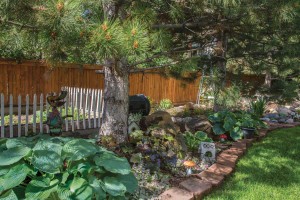 Luckily for Richard, Kirsten had some previous gardening experience. After purchasing a new home years earlier and seeing the barren yard with hard dirt and no landscaping, she took it upon herself to learn a few things.
“At first, when I didn’t know anything, I’d just plant any old plant in any old place where I thought it would look nice, paying little attention to how much sun or water it needed, and without ever amending the soil,” she says. “But after numerous costly failures, I decided to educate myself.” She bought several gardening books, chatted up local nursery employees about plants, trees, deck-building and other topics, and signed up for a weekend-long pond-construction class that required participants to build a pond from start to finish.
Luckily for Richard, Kirsten had some previous gardening experience. After purchasing a new home years earlier and seeing the barren yard with hard dirt and no landscaping, she took it upon herself to learn a few things.
“At first, when I didn’t know anything, I’d just plant any old plant in any old place where I thought it would look nice, paying little attention to how much sun or water it needed, and without ever amending the soil,” she says. “But after numerous costly failures, I decided to educate myself.” She bought several gardening books, chatted up local nursery employees about plants, trees, deck-building and other topics, and signed up for a weekend-long pond-construction class that required participants to build a pond from start to finish.
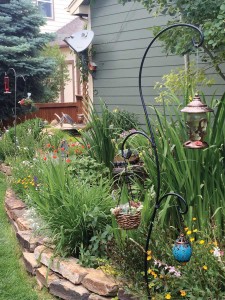 “The class really put things into perspective,” Kirsten says. “I figured if twelve people could build a pond in a weekend, surely I could do it over the course of a summer, and I did.” It took a long time to finish, and she had a little help from some friends, but when it was done, “it felt like a hard-earned victory,” she says.
When she moved in with Richard, it was really difficult saying good-bye to her yard and especially the pond, but she was anxious to help Richard plan “a new little oasis,” she says.
“The class really put things into perspective,” Kirsten says. “I figured if twelve people could build a pond in a weekend, surely I could do it over the course of a summer, and I did.” It took a long time to finish, and she had a little help from some friends, but when it was done, “it felt like a hard-earned victory,” she says.
When she moved in with Richard, it was really difficult saying good-bye to her yard and especially the pond, but she was anxious to help Richard plan “a new little oasis,” she says.
Gone Fishin’
Their first project was adding a patio because “the existing patio’s only purpose was that it had steps to walk down to the grass,” Richard quips. Built with a lot of trial and error, the patio was roomy enough for a table and chairs so they could dine and relax outdoors. Next, Kirsten convinced Richard to help her dig a pond next to the patio. Richard, who always liked to tinker, “really liked the idea of adding fish,” having already crafted a large aquarium inside the home that he built into a wall between the dining and living rooms.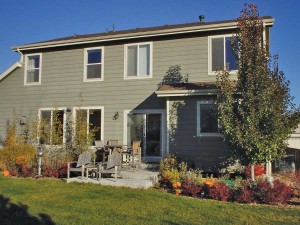 In the months leading up to the wedding, the couple built a pergola over the deck. “We wanted our guests to have shade,” Kirsten explains. “And we wanted to be able to sit on our patio after the wedding without being blinded by the sun,” Richard adds.
In the months leading up to the wedding, the couple built a pergola over the deck. “We wanted our guests to have shade,” Kirsten explains. “And we wanted to be able to sit on our patio after the wedding without being blinded by the sun,” Richard adds.
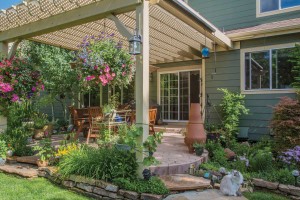
Knowing When to Morph
For Kirsten, the experience with the pear tree illustrates the fact that gardens, no matter how well established, are always morphing, and you have to morph right along with them. “That Cleveland pear tree had always provided shade for the plants underneath,” she explains, “so naturally I’d chosen shade-loving plants for that space. With the tree gone, the spot was in full sun, so I really had to rethink things.” She planted a small Japanese ‘Shirazz’ maple in its place and surrounded it with colorful foxglove, mums, mini roses, gaillardia, vinca vine and one of her favorites, Asiatic lilies.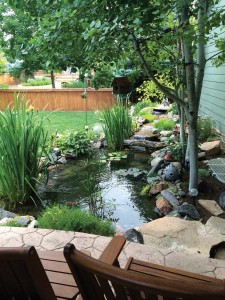 “Now, as the tree grows over the years and the space becomes shady again, the plants underneath will probably have to change, too,” Kirsten muses. It turns out that she and Richard won’t be the ones to do the changing, however—the couple moved from their home late last fall, and Kirsten had to say goodbye to another yard and pond she worked so hard on.
“We were sad to leave our home, our beautiful garden, and of course our neighbors,” Kirsten says, “but we couldn’t pass up the chance to own a lot of acreage, like we always dreamed of.” They sold their home to a young couple and moved a bit north to a 35-acre parcel near Carter Lake, complete with a house and barn—and another barren yard. The couple is ready to take on new challenges and new projects, though, including raising miniature Hereford cattle, but Kirsten wanted to be sure she was leaving their old garden in good hands.
“I hope they love the house and the garden as much as we did,” Kirsten says. “Actually, after hearing them talk about it, I know they will, and that makes me happy.”
“I’m sure they’ll enjoy it,” Richard adds. “All the hard work Kirsten asked me to help with really made for a beautiful backyard that we enjoyed so much over the years. Thank you, Kirsten—you were right. Now, let’s do it again.”
“Now, as the tree grows over the years and the space becomes shady again, the plants underneath will probably have to change, too,” Kirsten muses. It turns out that she and Richard won’t be the ones to do the changing, however—the couple moved from their home late last fall, and Kirsten had to say goodbye to another yard and pond she worked so hard on.
“We were sad to leave our home, our beautiful garden, and of course our neighbors,” Kirsten says, “but we couldn’t pass up the chance to own a lot of acreage, like we always dreamed of.” They sold their home to a young couple and moved a bit north to a 35-acre parcel near Carter Lake, complete with a house and barn—and another barren yard. The couple is ready to take on new challenges and new projects, though, including raising miniature Hereford cattle, but Kirsten wanted to be sure she was leaving their old garden in good hands.
“I hope they love the house and the garden as much as we did,” Kirsten says. “Actually, after hearing them talk about it, I know they will, and that makes me happy.”
“I’m sure they’ll enjoy it,” Richard adds. “All the hard work Kirsten asked me to help with really made for a beautiful backyard that we enjoyed so much over the years. Thank you, Kirsten—you were right. Now, let’s do it again.” 

